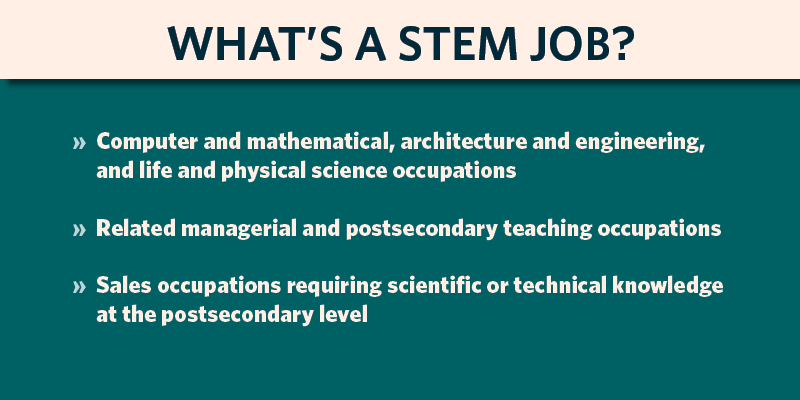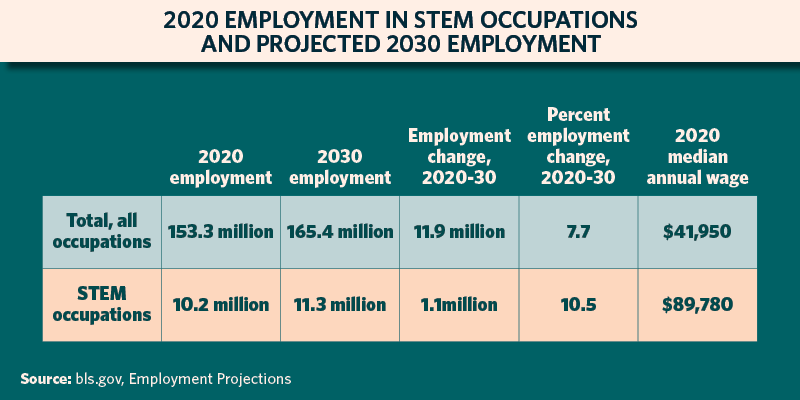Friday, February 11 is International Day of Women and Girls in Science. This day is an opportune time to look at employment statistics for women working in science, technology, engineering, and mathematics, or STEM.

Employment statistics from the Current Population Survey show that women’s full-time employment has increased in many STEM occupations over the past decade, reaching a level of 2.3 million in 2021.
As a group, STEM occupations are projected to grow 10.5% between 2020 and 2030, faster than the average for all occupations (7.7%). These STEM occupations pay more, and sometimes significantly more, than the median annual wage for all occupations of $41,950. Overall, STEM occupations had a median annual wage of $89,780 in May 2020.

Here are five STEM occupations that are projected to grow faster than average from 2020–30, and in some cases much faster than average, in which at least 1 in 6 jobs were held by women:
Information security analysts
Information security analysts plan and carry out security measures to protect an organization’s computer networks and systems.
Women’s share of employment, 2021: 18%
2020 annual median pay: $103,590 per year
Typical entry-level education: Bachelor’s degree
Number of jobs, 2020: 141,200
Projected growth, 2020–2030: 33% (much faster than average)
Occupational openings, 2020–2030 annual average: 16,300
Software developers and software quality assurance analysts and testers
Software developers design computer applications or programs. Software quality assurance analysts and testers identify problems with applications or programs and report defects.
Women’s share of employment, 2021: 20% (software developers) and 47% (software quality assurance analysts and testers)
2020 annual median pay: $110,140 per year
Typical entry-level education: Bachelor’s degree
Number of jobs, 2020: 1,847,900
Projected growth, 2020–2030: 22% (much faster than average)
Occupational openings, 2020–2030 annual average: 189,200
Operations research analysts
Operations research analysts use advanced mathematical and analytical methods to help solve complex issues.
Women’s share of employment, 2021: 51%
2020 annual median pay: $86,200 per year
Typical entry-level education: Bachelor’s degree
Number of jobs, 2020: 104,100
Projected growth, 2020–2030: 25% (much faster than average)
Occupational openings, 2020–2030 annual average: 10,200
Industrial engineers, including health and safety
Industrial engineers devise efficient systems that integrate workers, machines, materials, information, and energy to make a product or provide a service.
Women’s share of employment, 2021: 26%
2020 annual median pay: $88,950 per year
Typical entry-level education: Bachelor’s degree
Number of jobs, 2020: 292,000
Projected growth, 2020–2030: 14% (faster than average)
Occupational openings, 2020–2030 annual average: 23,300
Medical scientists
Medical scientists conduct research aimed at improving overall human health.
Women’s share of employment, 2021: 50%
2020 annual median pay: $91,510 per year
Typical entry-level education: Doctoral or professional degree
Number of jobs, 2020: 133,900
Projected growth, 2020–2030: 17% (much faster than average)
Occupational openings, 2020–2030 annual average: 12,600
Find more data on the U.S. workforce.
See how the department is investing in opportunities to connect women to STEM and other nontraditional occupations.
Christine Machovec is an economist in the Department of Labor’s Bureau of Labor Statistics. Follow BLS on Twitter at @BLS_gov.

 U.S. Department of Labor Blog
U.S. Department of Labor Blog